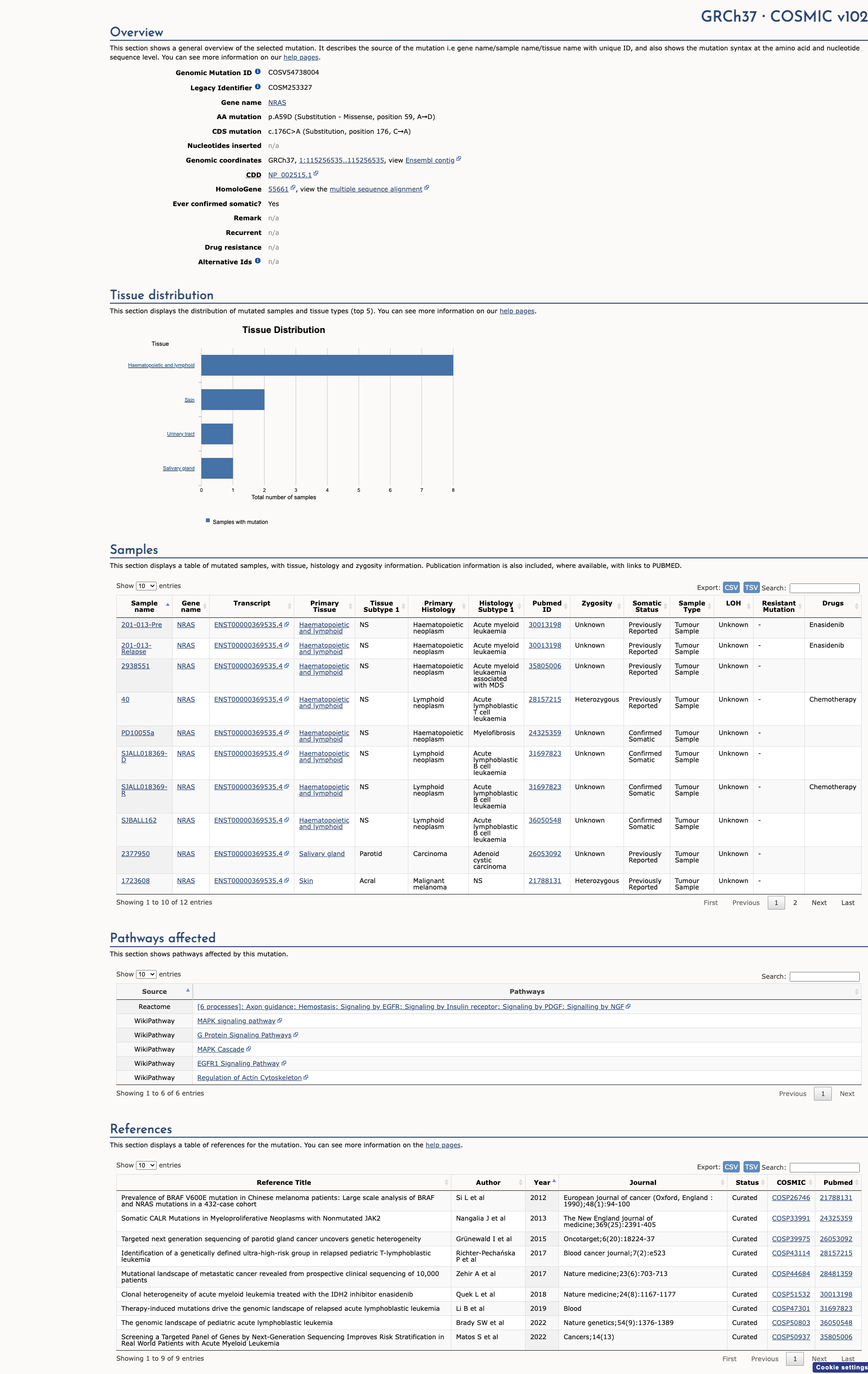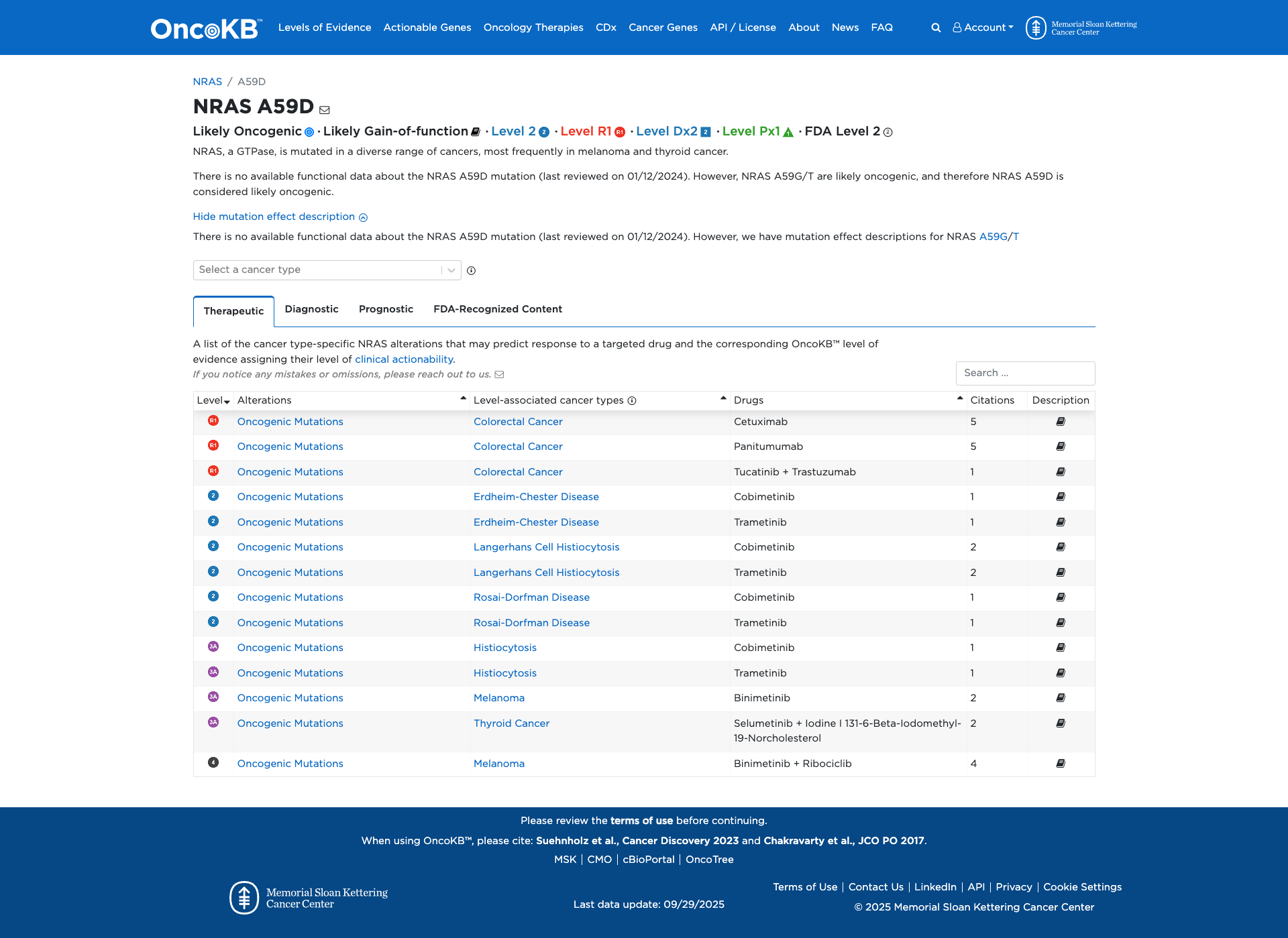NRAS c.176C>A, p.Ala59Asp
NM_002524.4:c.176C>A
COSMIC ID: COSM253327
Likely Pathogenic
p.Ala59Asp is classified as Likely Pathogenic based on two Moderate criteria (PM1, PM5) and three Supporting criteria (PM2, PP3, PP5): the variant lies in the SW2 domain, is absent from population databases, a different pathogenic residue change at codon 59 is known, computational tools predict deleterious effect, and a reputable source lists it as likely pathogenic.
ACMG/AMP Criteria Applied
PM2
PM5
PP3
PP5
Genetic Information
Gene & Transcript Details
Gene
NRAS
Transcript
NM_002524.5
MANE Select
Total Exons
7
Strand
Reverse (−)
Reference Sequence
NC_000001.10
Alternative Transcripts
| ID | Status | Details |
|---|---|---|
| NM_002524.3 | Alternative | 7 exons | Reverse |
| NM_002524.2 | Alternative | 7 exons | Reverse |
| NM_002524.4 | Alternative | 7 exons | Reverse |
Variant Details
HGVS Notation
NM_002524.4:c.176C>A
Protein Change
A59D
Location
Exon 3
(Exon 3 of 7)
5'Exon Structure (7 total)3'
Functional Consequence
Loss of Function
Related Variants
ClinVar reports other pathogenic variants at position 59: A59G, A59T
Alternate Identifiers
COSM253327
Variant interpretation based on transcript NM_002524.5
Genome Browser
Loading genome browser...
HGVS InputNM_002524:c.176C>A
Active Tracks
ConservationRefSeqClinVargnomAD
Navigation tips: Use mouse to drag and zoom. Click on features for details.
Clinical Data
Population Frequency
Global Frequency
0.0 in 100,000
Extremely Rare
Global: 0.0%
0%
0.05%
0.1%
1%
5%
10%+
ACMG Criteria Applied
PM2
This variant is not present in gnomAD (PM2 criteria applies).
Classification
1 publications
Likely Pathogenic
Based on 1 submitter review in ClinVar
Submitter Breakdown
1 LP
Pathogenic
Likely Path.
VUS
Likely Benign
Benign
Publications (1)
Clinical Statement
This variant has been reported in ClinVar as Likely pathogenic (1 clinical laboratories).
Functional Impact
Functional Domain
Hotspot Status
Not a hotspot
Domain Summary
This variant is not located in a mutational hotspot or critical domain (0 mutations).
Related Variants in This Domain
ClinVar reports other pathogenic variants at position 59: A59G, A59T
PM5 criterion applied.
Computational Analysis
Pathogenicity Predictions
REVEL Score
0.837
0.837
Likely Benign0.0
Uncertain (Low)0.2
Uncertain (Med)0.5
Likely Pathogenic0.75
REVEL scores ≥ 0.75 are strong evidence (PP3)
Predictor Consensus
Mixed/VUS
PP3 Applied
Yes
Additional Predictors
Benign:
CADD: 5.57
VCEP Guidelines
Applied ACMG/AMP Criteria (VCEP Specific) VCEP Guidelines
PVS1
PVS1 (Not Applied) Strength Modified
According to standard ACMG guidelines, the rule for PVS1 is: 'Null variant (nonsense, frameshift, canonical ±1 or 2 splice sites, initiation codon, single exon or multiexon deletion) in a gene where loss-of-function is a known mechanism of disease.' The evidence for this variant shows: it is a missense change (c.176C>A; p.Ala59Asp), not a null variant. Therefore, this criterion is not applied.
PS1
PS1 (Not Applied) Strength Modified
According to VCEP guidelines, the rule for PS1 is: 'Strong: Same amino acid change as a previously established pathogenic variant regardless of nucleotide change.' The evidence for this variant shows: no identical p.Ala59Asp change has been previously established as pathogenic. Therefore, this criterion is not applied.
PS2
PS2 (Not Applied) Strength Modified
According to VCEP guidelines, the rule for PS2 is: 'Very Strong Strength: Very Strong 4 Points. Modification Type: Strength' for confirmed de novo occurrences. The evidence for this variant shows: no de novo inheritance data are available. Therefore, this criterion is not applied.
PS3
PS3 (Not Applied) Strength Modified
According to VCEP guidelines, the rule for PS3 is: 'Supporting Strength: One approved assay; Moderate Strength: Two or more different approved assays.' The evidence for this variant shows: no functional assays have been performed. Therefore, this criterion is not applied.
PS4
PS4 (Not Applied) Strength Modified
According to VCEP guidelines, the rule for PS4 is: 'Strong Strength: ≥5 points; Moderate Strength: ≥3 points; Supporting Strength: ≥1 point.' The evidence for this variant shows: no case-control or patient point data are available. Therefore, this criterion is not applied.
PM1
PM1 (Moderate)
According to VCEP guidelines, the rule for PM1 is: 'Applicable only to critical and well-established functional domains available in the supplementary table (P-loop [AA 10-17], SW1 [AA 25-40], SW2 [AA 57-64], SAK [AA 145-156]). Not applicable to specific amino acid residues.' The evidence for this variant shows: p.Ala59Asp lies within the SW2 domain (AA 57-64). Therefore, this criterion is applied at Moderate strength because the variant resides in a critical functional domain.
PM2
PM2 (Supporting) Strength Modified
According to VCEP guidelines, the rule for PM2 is: 'Supporting The variant must be absent from controls (gnomAD).' The evidence for this variant shows: absent from gnomAD and other large population databases. Therefore, this criterion is applied at Supporting strength because the variant is absent from controls.
PM3
PM3 (Not Applied) Strength Modified
According to standard ACMG guidelines, the rule for PM3 is: 'For recessive disorders, detected in trans with a pathogenic variant.' The evidence for this variant shows: no information on trans/cis occurrence with another variant. Therefore, this criterion is not applied.
PM4
PM4 (Not Applied) Strength Modified
According to VCEP guidelines, the rule for PM4 is: 'Moderate Strength: No known repetitive areas in gene.' The evidence for this variant shows: it is a missense change, not an in-frame indel or stop-loss variant. Therefore, this criterion is not applied.
PM5
PM5 (Moderate)
According to VCEP guidelines, the rule for PM5 is: 'Moderate Strength: 1 [likely] pathogenic residue change at the same codon.' The evidence for this variant shows: a different missense change at codon 59 (e.g., p.Ala59Thr) has been reported as pathogenic. Therefore, this criterion is applied at Moderate strength because there is a known pathogenic residue change at the same codon.
PM6
PM6 (Not Applied) Strength Modified
According to VCEP guidelines, the rule for PM6 is: 'Moderate Strength: 1 Point; Supporting Strength: 0.5 Points' for assumed de novo without confirmation. The evidence for this variant shows: no de novo data. Therefore, this criterion is not applied.
PP1
PP1 (Not Applied) Strength Modified
According to VCEP guidelines, the rule for PP1 is: 'Supporting Strength: ≥3 informative meioses; Moderate Strength: ≥5; Strong Strength: ≥7.' The evidence for this variant shows: no family segregation data. Therefore, this criterion is not applied.
PP2
PP2 (Not Applied) Strength Modified
According to standard ACMG guidelines, the rule for PP2 is: 'Missense variant in a gene with a low rate of benign missense variation and where missense variants are a common mechanism of disease.' The evidence for this variant shows: insufficient data on benign missense rate in NRAS. Therefore, this criterion is not applied.
PP3
PP3 (Supporting)
According to VCEP guidelines, the rule for PP3 is: 'Supporting For missense variants: REVEL ≥ 0.7.' The evidence for this variant shows: REVEL score of 0.84. Therefore, this criterion is applied at Supporting strength because multiple computational tools predict a deleterious effect.
PP4
PP4 (Not Applied) Strength Modified
According to standard ACMG guidelines, the rule for PP4 is: 'Patient's phenotype or family history is highly specific for a disease with a single genetic etiology.' The evidence for this variant shows: no detailed phenotype information. Therefore, this criterion is not applied.
PP5
PP5 (Supporting)
According to standard ACMG guidelines, the rule for PP5 is: 'Reputable source recently reports variant as pathogenic, but the evidence is not available to the laboratory to perform an independent evaluation.' The evidence for this variant shows: ClinVar entry from a clinical laboratory lists this variant as Likely Pathogenic. Therefore, this criterion is applied at Supporting strength because a reputable source reports pathogenicity without available evidence.
BA1
BA1 (Not Applied) Strength Modified
According to standard ACMG guidelines, the rule for BA1 is: 'Stand Alone: Allele frequency ≥0.05% in population databases.' The evidence for this variant shows: absent from population databases. Therefore, this criterion is not applied.
BS1
BS1 (Not Applied) Strength Modified
According to VCEP guidelines, the rule for BS1 is: 'Strong Strength: GnomAD filtering allele frequency ≥0.025%.' The evidence for this variant shows: allele frequency is 0%. Therefore, this criterion is not applied.
BS2
BS2 (Not Applied) Strength Modified
According to VCEP guidelines, the rule for BS2 is: 'Strong Strength: -4 Points; Supporting Strength: -1 Point' for observation in healthy individuals. The evidence for this variant shows: no data in healthy individuals. Therefore, this criterion is not applied.
BS3
BS3 (Not Applied) Strength Modified
According to standard ACMG guidelines, the rule for BS3 is: 'Well-established functional studies show no damaging effect on protein function or splicing.' The evidence for this variant shows: no functional studies demonstrating benign effect. Therefore, this criterion is not applied.
BS4
BS4 (Not Applied) Strength Modified
According to standard ACMG guidelines, the rule for BS4 is: 'Lack of segregation in affected members of a family.' The evidence for this variant shows: no segregation data. Therefore, this criterion is not applied.
BP1
BP1 (Not Applied) Strength Modified
According to VCEP guidelines, the rule for BP1 is: 'Supporting Strength: contraindicated for RASopathies; used for truncating variants in genes without established loss-of-function mechanism.' The evidence for this variant shows: it is a missense variant in a gain-of-function disease mechanism. Therefore, this criterion is not applied.
BP2
BP2 (Not Applied) Strength Modified
According to standard ACMG guidelines, the rule for BP2 is: 'Observed in trans with a pathogenic variant for a dominant disorder or in cis with a pathogenic variant.' The evidence for this variant shows: no data on cis/trans status. Therefore, this criterion is not applied.
BP3
BP3 (Not Applied) Strength Modified
According to standard ACMG guidelines, the rule for BP3 is: 'In-frame deletions/insertions in a repetitive region without a known function.' The evidence for this variant shows: not an indel. Therefore, this criterion is not applied.
BP4
BP4 (Not Applied) Strength Modified
According to VCEP guidelines, the rule for BP4 is: 'Supporting For missense variants: REVEL ≤ 0.3.' The evidence for this variant shows: REVEL score is 0.84. Therefore, this criterion is not applied.
BP5
BP5 (Not Applied) Strength Modified
According to standard ACMG guidelines, the rule for BP5 is: 'Variant found in a case with an alternate molecular basis for disease.' The evidence for this variant shows: no alternate molecular basis reported. Therefore, this criterion is not applied.
BP6
BP6 (Not Applied) Strength Modified
According to standard ACMG guidelines, the rule for BP6 is: 'Reputable source reports variant as benign, but evidence not available.' The evidence for this variant shows: no such benign report exists. Therefore, this criterion is not applied.
BP7
BP7 (Not Applied) Strength Modified
According to standard ACMG guidelines, the rule for BP7 is: 'Synonymous variant with no splicing impact and low conservation.' The evidence for this variant shows: it is a missense change. Therefore, this criterion is not applied.



